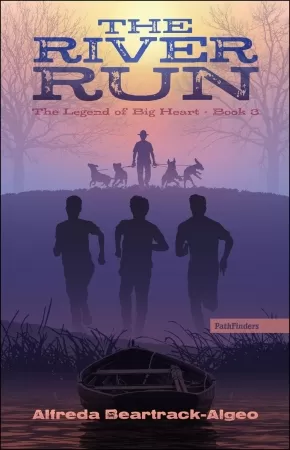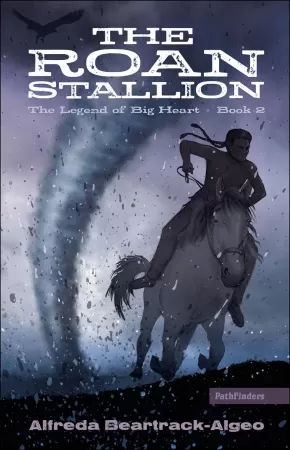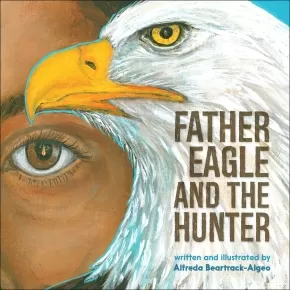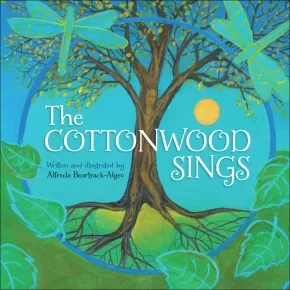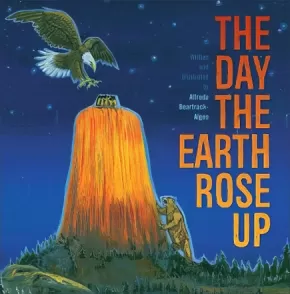
Alfreda Beartrack-Alego
Alfreda Beartrack-Algeo is a storyteller, poet, artist and illustrator. Her recent book, The Day the Earth Rose Up, is her Lakota version of the story of the Pleiades star constellation. She is a member of the Lower Brule Lakota Nation, Kul Wicasa Oyate, Lower Brule, South Dakota. Alfreda grew up surrounded by her tiyóspaye, her circle of family and friends and uses stories she heard as a child, along with various art forms, in all her work. “As long as I have a story left to tell, I feel I have a responsibility to gift that story forward.” Alfreda currently lives in beautiful Palisade, Colorado.
Teen Books (3)
The Land Grab
$12.95
Format:
Paperback
Text Content Territories:
Indigenous American; Native American; Sioux; Lakota;
ISBN / Barcode: 9781939053404
Synopsis:
Synopsis:
In 1929, a corrupt land agent used fire and frightening tactics to grab the farm of a Lakota family in Lower Brule, South Dakota.
In 1929 Alfred is eleven years old and has many responsibilities not expected of a young boy. He and his Lakota family are being forced to leave behind their tribal values and traditions and assimilate into mainstream American culture and society. His Lalá (grandfather), has instilled in his grandson many Lakota traditions which Alfred respects, but at times struggles to understand the message they convey. From falling into a den of rattlesnakes, fending off a pack of wolves, to skirmishes with a ruthless land agent and his cronies, this is a page-turner of historical fiction.
Educator & Series Information
Recommended for grades 9 to 12.
This book has a Fry Reading Level of 6.
This is Book 1 in the The Legend of Big Heart Series. The Legend of Big Heart Series takes place during the early twentieth century amid the forced assimilation of Native tribes into mainstream America. The series features the exciting adventures of young Alfred Swallow as he matures into a man and helps his family survive and prosper on the Lower Brule Lakota Reservation in South Dakota.
This is a work of historical fiction. All incidents, events, dialogue, names, and characters except for some well-known historical figures are products of the author’s imagination and are not to be construed as real. Where real-life historical figures appear, the situations, incidents, and dialogues concerning those persons are fictional and are not intended to depict actual events. In all other respects, any likeness to actual persons, living or dead, or actual events is purely coincidental.
This book is part of the PathFinders series of Hi-Lo (high interest, low readability) novels, which offers the following features:
• Indigenous teen protagonists
• Age-appropriate plots
• Contemporary and historical fiction
• Indigenous authors
The PathFinders series is from an American publisher. Therefore, Indigenous terminology in the PathFinders books is not the same as Canadian Indigenous terminology. This prompts a useful teaching moment for educators in discussing appropriate terminology use in Canada.
Additional Information
118 pages | 4.50" x 6.90" | Paperback
The River Run
$12.95
Format:
Paperback
Text Content Territories:
Indigenous American; Native American; Sioux; Lakota;
ISBN / Barcode: 9781570674136
Synopsis:
Synopsis:
The River Run is the third installment in The Legend of Big Heart series. To fulfill the government's policy to -- destroy the Indian and save the man -- Alfred Swallow and his friends Orson and Junior are forced to leave their families and homes to attend a residential mission school.
The students' beautiful long hair is cut, and they are forbidden to speak their native language. Even the slightest infraction is severely punished. At the height of hopelessness, Alfred gets a ghostly visit from beyond the grave, telling him to run to the river. With a bounty on their heads, Alfred and his friends Orson and Junior plunge into a harrowing quest for freedom.
The boys must rely on their instincts and intelligence as their journey takes them to Sioux City, Iowa. Here they find work at a carnival, but their jobs lead them into the underground world of gangsters and crime, and ultimately to Alfred's missing parents.
Educator & Series Information
Recommended for teens.
This is Book 3 in the The Legend of Big Heart Series. The Legend of Big Heart Series takes place during the early twentieth century amid the forced assimilation of Native tribes into mainstream America. The series features the exciting adventures of young Alfred Swallow as he matures into a man and helps his family survive and prosper on the Lower Brule Lakota Reservation in South Dakota.
This is a work of historical fiction. All incidents, events, dialogue, names, and characters except for some well-known historical figures are products of the author’s imagination and are not to be construed as real. Where real-life historical figures appear, the situations, incidents, and dialogues concerning those persons are fictional and are not intended to depict actual events. In all other respects, any likeness to actual persons, living or dead, or actual events is purely coincidental.
This book is part of the PathFinders series of Hi-Lo (high interest, low readability) novels, which offers the following features:
• Indigenous teen protagonists
• Age-appropriate plots
• Contemporary and historical fiction
• Indigenous authors
The PathFinders series is from an American publisher. Therefore, Indigenous terminology in the PathFinders books is not the same as Canadian Indigenous terminology. This prompts a useful teaching moment for educators in discussing appropriate terminology use in Canada.
Additional Information
160 pages | 4.50" x 7.00" | Paperback
The Roan Stallion
$12.95
Format:
Paperback
Text Content Territories:
Indigenous American; Native American; Sioux; Lakota;
ISBN / Barcode: 9781939053480
Synopsis:
Synopsis:
This hi-lo teen novel is filled with excitement. Alfred Swallow meets a wild roan stallion that is not an ordinary horse, but a medicine hat roan stallion that is believed to have special powers. The bond between Alfred and the stallion reaches far into a world of hopes and dreams. It's 1929 and times are hard for Alfred's Lakota family on the Dakota prairie. Alfred knows his grandfather could use a new tractor, so with the help of his friends and the roan stallion, he makes plans to win the prize money at the annual White River Relay Race. But time is short, as the race is just weeks away. Unaware of the dangers that lie ahead, Alfred prepares to train the horse. Even though the odds are against Alfred and his team, something in the grandstand catches his eye on the day of the race, and that changes everything. Can Alfred's determination and prayers carry them through to win?
Educator & Series Information
Recommended for teens.
This is Book 2 in the The Legend of Big Heart Series. The Legend of Big Heart Series takes place during the early twentieth century amid the forced assimilation of Native tribes into mainstream America. The series features the exciting adventures of young Alfred Swallow as he matures into a man and helps his family survive and prosper on the Lower Brule Lakota Reservation in South Dakota.
This is a work of historical fiction. All incidents, events, dialogue, names, and characters except for some well-known historical figures are products of the author’s imagination and are not to be construed as real. Where real-life historical figures appear, the situations, incidents, and dialogues concerning those persons are fictional and are not intended to depict actual events. In all other respects, any likeness to actual persons, living or dead, or actual events is purely coincidental.
This book is part of the PathFinders series of Hi-Lo (high interest, low readability) novels, which offers the following features:
• Indigenous teen protagonists
• Age-appropriate plots
• Contemporary and historical fiction
• Indigenous authors
The PathFinders series is from an American publisher. Therefore, Indigenous terminology in the PathFinders books is not the same as Canadian Indigenous terminology. This prompts a useful teaching moment for educators in discussing appropriate terminology use in Canada.
Additional Information
128 pages | 4.50" x 7.00" | Paperback
Kids Books (3)
Father Eagle and the Hunter
$18.95
Format:
Paperback
Text Content Territories:
Indigenous American; Native American; Sioux; Lakota;
ISBN / Barcode: 9781939053497
Synopsis:
Synopsis:
A hunter needs to find food for his hungry children, but when he finds a nest of eaglets, will he be able to make them into soup?
The hunter was tired of only finding berries and seeds to feed his hungry village, so he decided to look far and wide for some meat to bring to them. When he spotted a tall tree, he climbed to the top and discovered a nest with three eaglets. "What a tasty soup the three little birds will make!" thought the hunter.
Hearing the warning cries of the eaglets, Father Eagle flew to their rescue. Father Eagle told the hunter that if he did not take the eaglets, he would ask the Great Spirit to help the village.
The hunter decided to trust Father Eagle and watched him soar high into the sky. Father Eagle returned and told the hunter that the Great Spirit would help his people and would not let his village perish.
From that day forward, the game was plentiful, the people flourished, and the Eagle was forever respected and honored.
Educator Information
Recommended for ages 6 to 8.
Additional information
40 pages | 5.50" x 8.50" | Paperback
The Cottonwood Sings
$18.95
Format:
Paperback
Text Content Territories:
Indigenous American; Native American; Sioux; Lakota;
ISBN / Barcode: 9780966931716
Synopsis:
Synopsis:
The Cottonwood Sings is the delightful story of the lovely Hunku (First Woman), who was immortal and never aged. The animals and plants loved her, but Hunku was lonely. Every day she would go to the riverbank and cry herself to sleep. Beaver, who lived in the river, fell in love with the beautiful Hunku and begged the Great Spirit to turn him into a man. The Great Spirit agreed, and Beaver became Takahe (First Man), but the Great Spirit told him that one day he would have to go back to being Beaver. Hunku and Takahe enjoyed their life together, and they had four beautiful daughters.
The day finally came when Beaver had to return to the river. Hunku missed her companion and asked the Great Spirit to turn her into a tree so she could always be close to Beaver. The Great Spirit agreed to her request, and to this day you will find cottonwood trees living near bodies of water and beavers living near cottonwood trees.
Educator Information
Recommended for grades 2 and under.
In this story, the four daughters marry the four songs of Tate, the Spirit of the Wind. Each couple journeys to one of the four directions to form a sacred medicine wheel.
Themes / Keywords: First Woman, First Man, Medicine Wheel, Cottonwood, Beaver, Traditional Stories, Indigenous Picture Books,
Additional Information
40 pages | 8.50" x 8.50" | Paperback
The Day the Earth Rose Up
$18.95
Text Content Territories:
Indigenous American; Native American; Sioux; Lakota;
ISBN / Barcode: 9781939053398
Synopsis:
Synopsis:
A Lakota author’s version of how the Pleiades, the Seven Sisters star formation, came to be.
When seven Lakota sisters venture deep into the forest to gather chokecherries, they are surprised and chased by Mato Sica, a giant bear known to eat people. The sisters run and climb up a short rock ledge and pray for help. The ground trembles and gives a sudden jolt, and they find themselves on top of a tall earth tower. A great giant eagle comes to their rescue and carries the seven sisters up to the Star Nation, where they are welcomed home and become the Wicincala Sakowin, also known as the Seven Sisters or Pleiades star formation.
Reviews
“Author/illustrator Beartrack-Algeo (Lower Brule Lakota Nation) creates a mystical world. [A] retelling of the story of Pleiades, the Seven Sisters star formation. Rich oil paintings accompany the lyrical telling. An opening glossary defines Lakota terms. Lovingly depicts the sacred relationship between Lakota people and their homeland.”— Kirkus Reviews
“Beartrack-Algeo’s love and pride of her (Lakota) culture and the land shines throughout the story.”— School Library Journal
Educator Information
Includes a glossary of Lakota words and phrases.
Concepts / Subjects: Indigenous; Lakota; Astronomy; Star Formations.
Recommended for ages 6 to 8.
Additional Information
40 pages | 8.50" x 8.50" | Paperback



